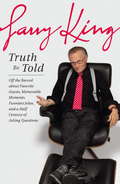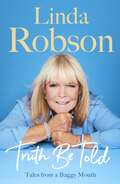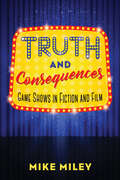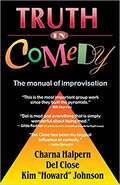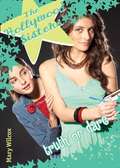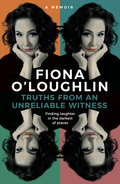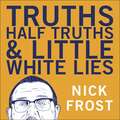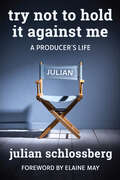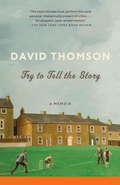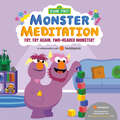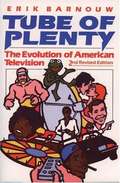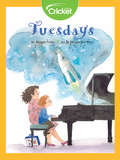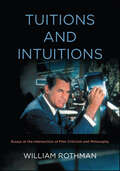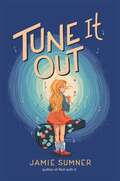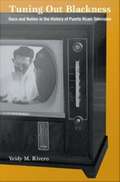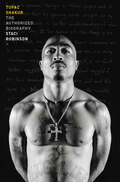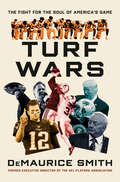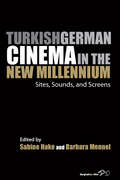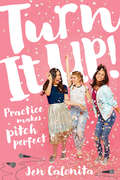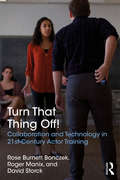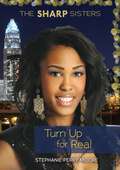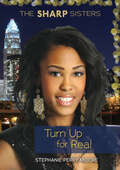- Table View
- List View
Truth Be Told: Off the Record about Favorite Guests, Memorable Moments, Funniest Jokes, and a Half Century of Asking Questions
by Larry KingTruth Be Told is a revealing and irresistibly entertaining look back on Larry's remarkable run at CNN, and an honest look at Larry's own life behind the scenes. After more than a half-century of asking questions, Larry King suddenly found everyone wanted answers from him. Was Larry King Live, CNN's highest rated program, ending after three decades? Was Larry getting divorced again? The paparazzi aimed their cameras at Larry. Jay Leno and other late-night talk-show hosts were having fun at his expense. And a cloud of uncertainty hovered over CNN. All of this forced Larry to look at changes in all aspects of his life, ultimately leading to his decision to leave Larry King Live and devote more time to his marriage and children. Larry reflects on how much the world has changed around him over the course of his fifty-year career, and he has a lot to say about everything and everyone: from marriage, politics, sports, entertainment, to the justice system, broadcasting, and the American future. Truth Be Told is a candid and surprising look inside the monumental career of one of the most powerful and legendary talk-show hosts as he signs off from the nightly television program that has been close to all of our hearts.
Truth Be Told: Tales from a Baggy Mouth
by Linda RobsonTHE SUNDAY TIMES BESTSELLING HILARIOUS AND HEARTFELT MEMOIR FROM LINDA ROBSON__________Linda Robson’s nickname is Baggy Mouth for good reason.She may be one of the nation’s favourite TV personalities – whether playing Tracey Stubbs in Birds of a Feather or being a regular on Loose Women – but she can’t help hilariously oversharing. Luckily, this is an ideal trait for her first-ever memoir . . .Taking us back to the very beginning, growing up in a North London council house, Linda explains how she came to attend theatre school aged nine, where she met Pauline Quirke.As their friendship blossomed and evolved into a professional partnership, small parts in theatre and film productions culminated in the pair being cast in the enduring and beloved sitcom Birds of a Feather.With a wicked glint in her eye, Linda recounts the twists and turns of an actor’s life, sharing tales of backstage antics, on-set stories and demanding co-stars from across her her varied and celebrated career.However, it has not all been laughter, and she candidly talks about the struggles she’s faced in her personal life and the battles she has had to overcome. Yet her determination to pull herself back from the brink shows us that the tough times really do make us stronger.Truth Be Told is funny, warm and loose-lipped about a remarkable life well-lived.__________PRAISE FOR TRUTH BE TOLD'Searingly honest' The Mail
Truth Facts: The Truthiest Truths and Factiest Facts of Everyday Life
by Mikael Wulff Anders MorgenthalerIn an age of "alternative facts," we all need a little more truth in our lives. And humor.Welcome to Truth Facts, a collection of information graphics that poke fun at societal quirks and everyday absurdities through charts and graphs. Danish writer Mikael Wulff and cartoon artist Anders Morgenthaler have taken the internet by storm with their humorous and perceptive infographics that turn commonplace phenomena into clever commentary. In distilling keen observations about universal experiences into elegant charts and graphs, Truth Facts gets to the heart of the paradoxical and wonderful world we all share, and puts modern reality into perspective in a funny and visceral way.These simple, colorful graphics explore societal quirks and everyday oddities, such as what happens when you call customer service (anything but service), when banks are open (only when you’re at work), the biggest lies on the internet (“LOL”), and much more.Playfully teasing readers even as it explores themes like perception vs. reality, this compendium of life’s truthiest facts prods us to laugh at ourselves, own up to our shortfalls, accept the strangeness of the world we live in, and continue on—happier and more connected to one another than ever before.
Truth and Consequences: Game Shows in Fiction and Film
by Mike MileyAlthough nearly every other television form or genre has undergone a massive critical and popular reassessment or resurgence in the past twenty years, the game show’s reputation has remained both remarkably stagnant and remarkably low. Scholarship on game shows concerns itself primarily with the history and aesthetics of the form, and few works assess the influence the format has had on American society or how the aesthetics and rhythms of contemporary life model themselves on the aesthetics and rhythms of game shows. In Truth and Consequences: Game Shows in Fiction and Film, author Mike Miley seeks to broaden the conversation about game shows by studying how they are represented in fiction and film. Writers and filmmakers find the game show to be the ideal metaphor for life in a media-saturated era, from selfhood to love to family to state power. The book is divided into “rounds,” each chapter looking at different themes that books and movies explore via the game show. By studying over two dozen works of fiction and film—bestsellers, blockbusters, disasters, modern legends, forgotten gems, award winners, self-published curios, and everything in between—Truth and Consequences argues that game shows offer a deeper understanding of modern-day America, a land of high-stakes spectacle where a game-show host can become president of the United States.
Truth in Comedy: The Manual of Improvisation
by Mike Myers Arthur L. Zapel Charna Halpern Del Close Kim H. JohnsonWant to learn the improv techniques that helped Mike Myers, Chris Farley, John Belushi, and many others along the road to TV and film stardom? Then let two esteemed founders of long-form improvisational theatre, Del Close and Charna Halpern, teach you the "Harold." <p><p> This groundbreaking acting exercise emphasizes pattern recognition and subversion of the audience s expectations, which are important factors for making people laugh without ever telling a joke. It involves six to seven players and many kinds of scenes: games, monologues, songs, skits and more, all of which are bound to keep both actors and audience members guessing. <p><p> The Harold is non-linear entertainment that remembers everything and wastes nothing the key to successful improvising and has become a standard in comedy clubs and improv theatres around the globe.
Truth or Dare (The Hollywood Sisters #5)
by Mary WilcoxOnly in L.A. would a school internship involve celebrity guest stars and hitting your mark. Acting is not my thing (can you say shy spasm?)... but mysteries are. I'm working as an extra on my sister's latest movie, and legend has it that the mansion we're filming in is haunted. With disappearing paintings, a glowing ghost, and Eva acting possessed (by love?), I'm starting to believe the stories are true! Chills. Thrills. Things that go bump in the night. Is my jinx on overdrive or have I stepped into a real-life horror flick?
Truths from an Unreliable Witness: Finding laughter in the darkest of places
by Fiona O'LoughlinFiona O'Loughlin was raised in the generation of children who were to be seen, but not heard ... unless there were guests in the house. Then she'd watch everyone, telling stories, making each other laugh. This was where she discovered the rhythm of stories and the lubrication that alcohol leant the telling. Years later, as a mum of five, Fiona would become one of Australia's most-loved comedians, performing gigs in New York, Montreal, Singapore, London, Toronto and Edinburgh. Fiona looked like she was living her dream - but she was hiding a secret in open sight, using alcoholism as material for her comedy and using comedy as an excuse for her alcoholism.Truths from an Unreliable Witness is a fiercely honest and wryly funny memoir of melancholy, love, marriage, the loss of love and marriage, homelessness, of hotel rooms strewn with empty mini-bar bottles of vodka, of waking from a two-week coma, of putrid drug dens and using a jungle to confront yourself. It is about hitting rock bottom and then realising you are only halfway down. Ultimately, it's about hanging on to your last straw of sanity and finding laughter in the darkest of times. You may want to sit down for this...
Truths, Half Truths and Little White Lies
by Nick Frost'If I'm going to tell the story of a life, my life, then I need to tell it warts and all. If the tale is too saccharine sweet then what can the reader take away from it? What do they learn about you? I've written everything down. The shit, the death, fun, naughtiness, addiction, laughter, laughter, laughter, some tears and lots of love and happiness. That to me is a better reflection of a human's life.'Nick's family life was difficult, blighted by alcoholism, illness and sudden misfortune meaning they lost everything overnight. He left school early and drifted from job to job dogged by his own personal demons. It's something of a miracle that Nick survived and even more that he would achieve such success with his writing, acting and comedy. In Truths, Half Truths and Little White Lies Nick paints a brilliantly funny, moving and brutally candid portrait of childhood, adolescence and eventual success.
Truths, Half Truths and Little White Lies
by Nick Frost'If I'm going to tell the story of a life, my life, then I need to tell it warts and all. If the tale is too saccharine sweet then what can the reader take away from it? What do they learn about you? I've written everything down. The shit, the death, fun, naughtiness, addiction, laughter, laughter, laughter, some tears and lots of love and happiness. That to me is a better reflection of a human's life.'Nick's family life was difficult, blighted by alcoholism, illness and sudden misfortune meaning they lost everything overnight. He left school early and drifted from job to job dogged by his own personal demons. It's something of a miracle that Nick survived and even more that he would achieve such success with his writing, acting and comedy. In Truths, Half Truths and Little White Lies Nick paints a brilliantly funny, moving and brutally candid portrait of childhood, adolescence and eventual success.(P)2015 Hodder & Stoughton
Try Not to Hold It Against Me
by Elaine May Julian SchlossbergVeteran motion picture, television, and Broadway producer Julian Schlossberg grew up in New York City with an early love of entertainment. As a child, he was an avid fan of radio, film, and the new art of television, and harbored ambitions of meeting his favorite stars one day. Little did he know that in the course of his career, he would not only meet many of them, but also become their producer, representative, and friend. During his nearly 60 years in show business, Schlossberg has worked as a producer, director, distributor, exhibitor, radio and television host, and record executive. At 27 he was the youngest head film buyer of a national theater chain; after working at the ABC network, the Walter Reade Organization, and Paramount Pictures, he would start his own motion-picture company, Castle Hill Productions, which would become one of the largest independent film-distribution companies in the world with a library of over 500 films. Not willing to restrict his efforts to film and television, he has also produced award-winning plays and musicals for Broadway and off-Broadway, working closely with brilliant writers and directors like Mike Nichols, Larry Gelbart, Susan Stroman, Woody Allen, and David Mamet. Now, in his memoir Try Not to Hold It Against Me, Schlossberg shares stories from a lifetime in entertainment, from his childhood in the Bronx to his years as a producer for screen and stage. Schlossberg takes us through the trials and triumphs of work and play in every avenue of the business: negotiating with Al Pacino, Burt Reynolds, and Lillian Hellman; hosting the syndicated radio and television production Movie Talk, which introduced him to hundreds of stars; experiencing the paranormal with Shirley MacLaine and Betty Hill; running the Orson Welles estate and restoring Welles' masterly film adaptation of Othello; partying with Barbra Streisand and Liza Minelli; testifying in a lawsuit against The Beatles; and interviewing over 120 of the most influential figures of the 20th century for his series Witnesses to the 20th Century. Written with engaging humor and self-deprecation—and with a foreword by Academy Award winner Elaine May—Try Not to Hold It Against Me gives readers a behind-the-scenes pass to Cannes and Las Vegas, the lives and homes of the stars, and the rarely seen but crucial work of the producer in the midst of it all. It's a compelling read for film, television, and theater enthusiasts alike—and a one-of-a-kind autobiography by one of entertainment's true insiders.
Try to Tell the Story: A Memoir
by David ThomsonDavid Thomson, one of our most celebrated film writers, gives us a haunting, fascinating memoir about growing up as an only child in wartime England. He was born in London in the aftermath of the war, where he was raised by his mother, grandmother, and upstairs tenant, Miss Davis. He remembers how his grandmother brought him to a street corner to see Churchill and how the bombed-out houses that still smelled of smoke became his playground. We see Thomson attempt to overcome his profound sadness at being abandonded by his cold and distant father by finding solace in the cinema houses. Movies became his great escape, and the worlds revealed in Red River, The Third Man, and Citizen Kane helped to alleviate his loneliness and bolster his rich imaginative life. From the Trade Paperback edition.Man, and Citizen Kane were part of his rich imaginative life, one that gained him a scholarship to public and eventually film school. And though his father could never tell his son he loved him, he spent the first part of vacations with him and he came back most weekends, taking Thomson to everything from boxing to cricket matches. But as Thomson admits, "I am still, years after his death, bewildered and pained by my father, and trying to love him--or find his love for me."Try to Tell the Story is a haunting and unsentimental look at the fragility of family relationships, a memoir of growing up in the absence of a full-time father, with movies and sports heroes as one's only touchstones.
Try, Try Again, Two-Headed Monster!: Sesame Street Monster Meditation in collaboration with Headspace (Monster Meditation)
by Random HouseTwo-Headed Monster learns fun breathing activities to help calm him when he gets frustrated—based on the popular Sesame Street Monster Meditation video on YouTube, made in collaboration with the mindfulness app Headspace.It can be frustrating when things don't go right—but giving up isn't the answer! This terrific board book features Two-Headed Monster learning a calming Monster Meditation. Now when his block tower falls down, he does the simple breathing games and starts building his tower again. Plus, there's an offer in the book for a free month of the Headspace app!This is book five in a series of six books, all inspired by the popular Sesame Street Monster Meditation videos on YouTube, which help young girls and boys learn mindfulness techniques along with their favorite characters. The videos are made in collaboration with the mindfulness app Headspace. The art style in the books is the same as in the videos—bright and simple, to appeal to the youngest Sesame Street fans.Sesame Workshop, the nonprofit educational organization behind Sesame Street, aims to help kids grow smarter, stronger, and kinder through its many unique domestic and international initiatives. These projects cover a wide array of topics for families around the world.
Tube of Plenty: The Evolution of American Television
by Erik BarnouwBased on the classic History of Broadcasting in the United States, Tube of Plenty represents the fruit of several decades' labor. When Erik Barnouw - premier chronicler of American broadcasting and a participant in the industry for fifty years - first undertook the project of recording its history, many viewed it as a light-weight literary task concerned mainly with "entertainment" trivia. Indeed, trivia such as that found in quiz programs do appear in the book, but Barnouw views themas part of a complex social tapestry that increasingly defines our era. To understand our century, we must fully comprehend the evolution of television and its newest extraordinary offshoots. With this fact in mind, Barnouw's new edition of Tube of Plenty explores the development and impact of the latest dramatic phases of the communications revolution. Since the first publication of this invaluable history of television and how it has shaped, and been shaped by, American cultureand society, many significant changes have occurred. Assessing the importance of these developments in a new chapter, Barnouw specifically covers the decline of the three major networks, the expansion of cable and satellite television and film channels such as HBO (Home Box Office), the success of channels catering to special audiences such as ESPN (Entertainment and Sports Programming Network) and MTV (Music Television), and the arrival of VCRs in America's living rooms. He also includes an appendix entitled "questions for a new millennium," which will challenge readers not only to examine the shape of television today, but also to envision its future.
Tuesdays
by Rhonda TelferFinn is reluctant to go to piano lessons, but when Miss Bea shows him how the instrument works, he begins to discover the magic of music.
Tuitions and Intuitions: Essays at the Intersection of Film Criticism and Philosophy (SUNY series, Horizons of Cinema)
by William RothmanWilliam Rothman has long been considered one of the seminal figures in the field of film-philosophy. From his landmark book Hitchcock: The Murderous Gaze, now in its second edition, to the essays collected here in Tuitions and Intuitions, Rothman has been guided by two intuitions: first, that his kind of film criticism is philosophy; and second, that such a marriage of criticism and philosophy has an essential part to play in the serious study of film. In this book, he aspires, borrowing a formulation from Emerson, to "pay the tuition" for these intuitions.Thoughtful, philosophically sophisticated, and provocative, the essays included here address a wide range of films, including classical Hollywood movies; the work of "auteur" directors like Alfred Hitchcock, George Cukor, Yasujirō Ozu, and Woody Allen; performances by John Barrymore and James Stewart; unconventional works by Jean Genet, Chantal Akerman, Terrence Malick, and the Dardenne brothers; the television series Justified; and documentaries by Jean Rouch, Ross McElwee, and Robert Gardner. All the essays address questions of philosophical significance and, taken together, manifest Rothman's lifelong commitment when writing about a film, to respect the film's own ideas; to remain open to the film's ways of expressing its ideas; and to let the film help teach him how to view it, how to think about it, and how to discover what he has at heart to say about it.
Tune In Yesterday: The Ultimate Encyclopedia of Old-time Radio, 1925-1976
by John DunningReadable short accounts of every old radio show you could possibly be interested in.
Tune It Out
by Jamie SumnerFrom the author of the acclaimed Roll with It comes a moving novel about a girl with a sensory processing disorder who has to find her own voice after her whole world turns upside down.Lou Montgomery has the voice of an angel, or so her mother tells her and anyone else who will listen. But Lou can only hear the fear in her own voice. She&’s never liked crowds or loud noises or even high fives; in fact, she&’s terrified of them, which makes her pretty sure there&’s something wrong with her. When Lou crashes their pickup on a dark and snowy road, child services separate the mother-daughter duo. Now she has to start all over again at a fancy private school far away from anything she&’s ever known. With help from an outgoing new friend, her aunt and uncle, and the school counselor, she begins to see things differently. A sensory processing disorder isn&’t something to be ashamed of, and music might just be the thing that saves Lou—and maybe her mom, too.
Tuning Out Blackness: Race & Nation in the History of Puerto Rican Television
by Yeidy M. RiveroTuning Out Blackness fills a glaring omission in U. S. and Latin American television studies by looking at the history of Puerto Rican television. In exploring the political and cultural dynamics that have shaped racial representations in Puerto Rico's commercial media from the late 1940s to the 1990s, Yeidy M. Rivero advances critical discussions about race, ethnicity, and the media. She shows that televisual representations of race have belied the racial egalitarianism that allegedly pervades Puerto Rico's national culture. White performers in blackface have often portrayed "blackness" in local television productions, while black actors have been largely excluded. Drawing on interviews, participant observation, archival research, and textual analysis, Rivero considers representations of race in Puerto Rico, taking into account how they are intertwined with the island's status as a U. S. commonwealth, its national culture, its relationship with Cuba before the Cuban Revolution in 1959, and the massive influx of Cuban migrants after 1960. She focuses on locally produced radio and television shows, particular television events, and characters that became popular media icons--from the performer Ramn Rivero's use of blackface and "black" voice in the 1940s and 1950s, to the battle between black actors and television industry officials over racism in the 1970s, to the creation, in the 1990s, of the first Puerto Rican situation comedy featuring a black family. As the twentieth century drew to a close, multinational corporations had purchased all Puerto Rican stations and threatened to wipe out locally produced programs. Tuning Out Blackness brings to the forefront the marginalization of nonwhite citizens in Puerto Rico's media culture and raises important questions about the significance of local sites of television production.
Tupac Shakur: The Authorized Biography
by Staci RobinsonThe authorized biography of the legendary artist, Tupac Shakur, a &“touching, empathetic portrait&” (The New York Times) of his life and powerful legacy, fully illustrated with photos, mementos, handwritten poetry, musings, and moreArtist, poet, actor, revolutionary, legendTupac Shakur is one of the greatest and most controversial artists of all time. More than a quarter of a century after his tragic death in 1996 at the age of just twenty-five, he continues to be one of the most misunderstood, complicated, and influential figures in modern history. Drawing on exclusive access to Tupac&’s private notebooks, letters, and uncensored conversations with those who loved and knew him best, this estate-authorized biography paints the fullest and most intimate picture to date of the young man who became a legend for generations to come.In Tupac Shakur, author and screenwriter Staci Robinson—who knew Tupac from their shared circle of high school friends in Marin City, California, and who was entrusted by his mother, Afeni Shakur, to share his story—unravels the myths and unpacks the complexities that have shadowed Tupac&’s existence. Decades in the making, this book pulls back the curtain to reveal a powerful story of a life defined by politics and art—a man driven by equal parts brilliance and impulsiveness, steeped in the rich intellectual tradition of Black empowerment, and unafraid to utter raw truths about race in America.It is a story of a mother and son bound together by a love for each other and for their people, and the relationship that endured through their darkest times. It is a political story that begins in the whirlwind of the 1960s civil rights movement and unfolds through a young artist&’s awakening to rage and purpose in the &’90s era of Rodney King. It is a story of dizzying success and its devastating consequences. And, of course, it is the story of Tupac&’s music, his timeless, undying message as it continues to touch and inspire us today.
Turf Wars: The Fight for the Soul of America's Game
by DeMaurice SmithAn NFL insider&’s explosive account of the ruthless power struggles between owners and players over the future of football.During his fourteen years as the head of the NFL Players Association, DeMaurice Smith was a front line advocate for football players through some of the most tumultuous crises in NFL history: Colin Kaepernick&’s protests, Deflategate, a lockout, two collective bargaining agreements, and more. But after witnessing the league&’s troubling response to discrimination and racial unrest, both within the league and beyond, Smith realized it was time to pull back the curtain and speak truth to power.Drawing from his years of unprecedented access and unparalleled knowledge of America&’s favorite sport, Smith documents his years leading the NFLPA and explains how the NFL distorts the truth, telling partial stories to insulate itself and grow its $20-billion-a-year brand—and the players&’ battles to protect themselves.From contract negotiations to battles over suspensions, Smith shows us how the union fought to protect players from the greed, racism, and dishonesty the league is built on. He also takes readers inside closed-door meetings and unreported conversations and confrontations with the industry&’s most powerful figures such as Robert Kraft, Jerry Jones, Tom Brady, and Roger Goodell.Turf Wars puts every NFL crisis—both familiar and lesser known—within a broader cultural and historical context, framing the league&’s extraordinary rise as a mirror to America&’s own history. Revelatory and profound, Turf Wars is a book about the soul of football: its degradation, and how to save it.
Turkish German Cinema in the New Millennium
by Sabine Hake Barbara MennelIn the last five years of the twentieth century, films by the second and third generation of the so-called German guest workers exploded onto the German film landscape. Self-confident, articulate, and dynamic, these films situate themselves in the global exchange of cinematic images, citing and rewriting American gangster narratives, Kung Fu action films, and paralleling other emergent European minority cinemas. This, the first book-length study on the topic, will function as an introduction to this emergent and growing cinema and offer a survey of important films and directors of the last two decades. In addition, it intervenes in the theoretical debates about Turkish German culture by engaging with different methodological approaches that originate in film studies.
Turn It Up!: Practice Makes Pitch Perfect
by Jen CalonitaFrom the author of the Fairy Tale Reform School and the Belles series comes a contemporary YA that sings with hilarity and fun.The Nightingales are in a serious funk. Bradley Academy's all-girl a cappella group used to be the pride of the sunshine state, but the Nightingales have recently fallen out of harmony. Best friends and co-captains Lidia Sato and Sydney Marino haven't been speaking ever since a boy came between them. And not just any boy-none other than Griffin Mancini, the lead singer of Bradley Academy's smug all-boy a capella group, the Kingfishers. The Nightingales have no chance of making it to the big state final if their captains are at each other's throats. Their only hope is new girl Julianna Ramirez. But in addition to her serious pipes, she has some serious stage fright. The Nightingales will have to come together if they want to shine at the upcoming competition and restore the group to its former glory.Turn It Up! follows Lidia, Sydney, and Julianna through the ups and downs of friendship, romance, competition, and finding the perfect song!
Turn That Thing Off!: Collaboration and Technology in 21st-Century Actor Training
by Rose Burnett Bonczek Roger Manix David StorckAs personal technology becomes ever-present in the classroom and rehearsal studio, its use and ubiquity is affecting the collaborative behaviors that should underpin actor training. How is the collaborative impulse being distracted and what kind of solutions can re-establish its connections? The daily work of a theater practitioner thrives on an ability to connect, empathize, and participate with other artists. This is true at every level, from performing arts students to established professionals. As smartphones, social media, and other forms of digital connectedness become more and more embedded in daily life, they can inhibit these collaborative, creative skills. Turn That Thing Off! Collaboration and Technology in 21st-Century Actor Training explores ways to foster these essential abilities, paving the way for emerging performers to be more present, available, and generous in their work.
Turn Up for Real (The Sharp Sisters #3)
by Stephanie Perry MooreSlade, Stanley Sharp's middle daughter, feels like the odd one out. All she wants is a group of friends who aren't her sisters—and a record deal. But after losing the Teen Miss Charlotte competition and having a bad experience at a recording studio, Slade feels her dreams slipping away. Can Slade be an advocate for the arts and a singing superstar, or is she just another pretty face?
Turn Up for Real (The\sharp Sisters Ser.)
by Stephanie Perry MooreSlade, Stanley Sharp's middle daughter, feels like the odd one out. All she wants is a group of friends who aren't her sisters—and a record deal. But after losing the Teen Miss Charlotte competition and having a bad experience at a recording studio, Slade feels her dreams slipping away. Can Slade be an advocate for the arts and a singing superstar, or is she just another pretty face?
